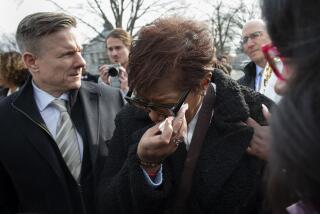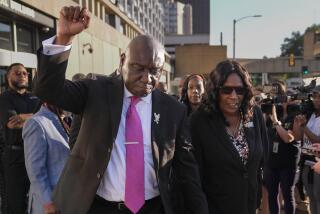Black Man’s Death Ruled Homocide
ST. LOUIS — Cincinnati’s coroner on Wednesday ruled the weekend death of Nathaniel Jones a homicide -- the direct result of Jones’ clash with six police officers who repeatedly struck him with nightsticks as they struggled to subdue him.
Hamilton County Coroner Carl Parrott Jr. quickly added that he was not implying the police had used excessive force. Calling the death a homicide, he said, “does not imply hostile or malign intent.”
But the fight with officers did stress -- and, ultimately, stop -- Jones’ heart, which was already weakened by coronary disease, high blood pressure, obesity and the intoxicating effects of cocaine and PCP, Parrott said.
“Accordingly, his death must be regarded as a direct and immediate consequence of the struggle,” the coroner said, explaining why he could not declare the death accidental.
The ruling infuriated police. “These officers did nothing wrong,” said Roger Webster, the president of the police union.
It also angered black activists, who seized on the coroner’s report as proof that police brutality in Cincinnati continues unchecked, despite much-heralded reforms. Jones was the 18th black man in the last eight years to be killed while fighting or fleeing Cincinnati officers.
“We’re really tired of this happening. We’re hurting,” said Patricia Carson, who runs a support group for mothers who have lost sons to violence on Cincinnati streets.
Carson pointed out that earlier this year, the city agreed to pay $3.1 million to families of two men fatally shot by police and another $1.4 million to victims of racial profiling by police. “You’d think the city of Cincinnati would learn,” she said.
“It would be nice if police officers were held accountable, if they were sent to jail for killing people,” added Juleana Frierson, a leader in the Black United Front, which has pressed for tourists and entertainers to boycott the city. “But I don’t see any changes. I don’t have any real hope.”
Her group is organizing a rally on the steps of City Hall for Sunday, followed by a march on the courthouse to call for justice.
The police officers’ union, meanwhile, issued its own call for justice -- for its men and women in uniform.
Union leaders have grown weary of pointing out that the 18 men lumped together as “victims of police brutality” included an ax-wielding killer who had just decapitated a teenager, a bank robber who shot at a teller as he fled and a 12-year-old driver who dragged a police officer to his death rather than pull over.
Jones was unarmed. But he weighed 350 pounds and he was behaving erratically. Mayor Charlie Luken has said that Jones’ bulk alone amounted to a “deadly weapon” and that the officers were right to react as though they were under potentially lethal attack when Jones lunged at them.
“To say it’s homicide, that’s a very inflammatory term,” said Webster, head of the Fraternal Order of Police. “There’s no criminal culpability here. These officers did everything by the book. They did not cause this man’s death. He caused it himself, because he chose to fight the police, because he chose to use those drugs.”
The struggle, which occurred around 6 a.m. Sunday, was captured by a video camera mounted in a police cruiser. Portions of the video have been replayed often on national TV. But there’s a 97-second gap in the tape -- a gap Jones’ supporters find highly suspicious.
The camera is set up to record automatically when a police car’s flashing blue lights are on. When the first officers arrived at the scene, responding to a call about a disturbance at a fast-food restaurant, they switched off their lights and walked up to Jones, who was outside dancing and yelling. The camera cut off at that point. It resumed recording 97 seconds later, when an officer went back to the cruiser to switch on the lights -- and the camera -- as the confrontation with Jones escalated.
An attorney for Jones’ family suggested Wednesday that the police might have provoked Jones during that unrecorded minute and a half, prompting him to take a swing at the officers. They shouted at him to get back and put his hands behind his back; he refused. They then began clubbing him with their nightsticks.
The coroner found superficial bruises, “consistent with nightstick injuries,” on the lower part of Jones’ body, but said the blows had not caused any damage to internal organs.
The police department and an independent civilian review board are investigating Jones’ death. The U.S. Department of Justice has begun gathering information that may lead to an investigation as well. The officers involved -- five are white and one is African American -- have been placed on paid administrative leave.
More to Read
Sign up for Essential California
The most important California stories and recommendations in your inbox every morning.
You may occasionally receive promotional content from the Los Angeles Times.










